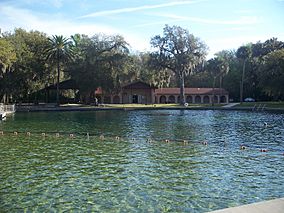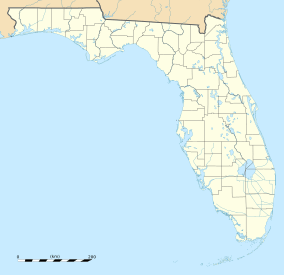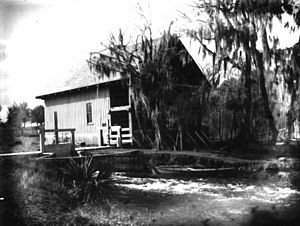De Leon Springs State Park facts for kids
Quick facts for kids De Leon Springs State Park |
|
|---|---|
|
IUCN Category V (Protected Landscape/Seascape)
|
|
 |
|
| Location | Volusia County, Florida, USA |
| Nearest city | DeLeon Springs, Florida |
| Established | 1970 |
| Governing body | Florida Department of Environmental Protection |
De Leon Springs State Park is a fun state park located in Volusia County, Florida. You can find it in the town of DeLeon Springs, right off CR 3. It's a great place to explore nature and learn about history!
Contents
What is De Leon Springs State Park?
This park covers 625 acres in Volusia County. Its main feature is a natural spring that flows with about 20 million gallons of water every day! The water stays at a cool 72 degrees Fahrenheit all year round. The deepest part of the spring, where the water bubbles up, is about 30 feet deep. This is known as a "Second Magnitude Spring" because of how much water it produces.
Animals You Might See
The park is home to lots of different wildlife. You might spot gentle manatees, big alligators, graceful white-tailed deer, slow-moving turtles, and playful otters.
Birds of the Park
Many kinds of birds live here too, like anhingas, egrets, powerful hawks, unique limpkins, fishing ospreys, and soaring vultures. Keep an eye out for American bald eagles, American white ibis, belted kingfishers, American coots, and great blue herons.
Seasonal Visitors
Sometimes, you might even see Florida black bears, especially since the park is connected to nearby forests and wildlife refuges. In winter, manatees often come to the warm spring water to escape the cold. You can also see many different kinds of ducks that migrate through the area.
A Look Back in Time: Park History
People have lived near this spring for a very long time—at least 6,000 years! In the 1980s and 1990s, two ancient dugout canoes were found in the spring. They were 5,000 and 6,000 years old, making them the oldest canoes ever found in the Western Hemisphere!
The Name and Early Settlers
Even though the park is called "De Leon Springs," there are no records that connect Juan Ponce de León to the spring. The area's name was changed from "Spring Garden" to "Ponce de Leon Springs" in 1886. This was done to attract tourists after a new railway was built.
Spanish missions were set up here in the late 1500s. The native people living here were called the Mayaca. They were different from the Timucuans because the Mayaca were fisher-hunter-gatherers, meaning they moved around to find food. The Timucuans, however, stayed in one place and grew crops.
Plantations and Mills
Spain got the land back from England in 1783. In 1804, they gave land, including the spring, to William Williams. He started the first plantation, calling it "Spring Garden." Here, crops like corn, cotton, and sugar cane were grown. Sadly, people were forced to work on this plantation.
Florida became part of the U.S. in 1821. Later, a man named Colonel Orlando Rees owned the plantation and built Florida's only water-powered sugar mill. The famous artist John James Audubon visited in 1836 and painted a limpkin bird there.
The plantation was destroyed twice: once in 1835 by the Seminole Indians during a war, and again in 1864 by Union troops during the American Civil War. After 1864, the mill building fell apart. It was rebuilt in the early 1900s, but then fell into disrepair again. In 1961, the Schwarze family fixed it up and opened the Old Spanish Sugar Mill Restaurant, which is still popular today!
A Tourist Hotspot
In the 1880s, the area became a popular tourist spot after the railroad arrived. People believed the spring had healing powers and called it the "Fountain of Youth." A hotel was built, and a small steamboat brought visitors.
In 1925, the fancy Ponce de Leon Hotel opened, attracting wealthier visitors. In 1953, the "Ponce de Leon Springs" attraction opened after a big renovation. It had exotic birds, alligator pens, nature trails, jungle cruises, and even two waterskiing elephants named Sunshine Sally and Queenie!
The attraction closed in the mid-1960s, and the old hotel was torn down. The property then became a private park. In 1980, a local group called "Save Our Spring" worked hard to convince the State of Florida and Volusia County to buy the spring and 55 acres of land. They succeeded, and in June 1982, De Leon Springs State Park officially opened!
Fun Things to Do
There are many exciting activities at De Leon Springs State Park!
Water Activities
You can go canoeing, kayaking, and fishing in the spring run. Swimming is allowed only in the main spring pool, which is a perfect spot to cool off.
Trails and Nature
The four-mile Wild Persimmon Hiking Trail winds through different natural areas like hardwood forests and cypress swamps. On this trail, you might see white-tailed deer, turkeys, wild hogs, and even Florida black bears! There's also a shorter, paved nature trail that is wheelchair accessible. It has signs that teach you about the plants and animals, and a boardwalk that leads to a huge 600-year-old bald cypress tree.
Park Amenities
The park has a swimming area, picnic spots with tables and grills, and picnic pavilions for groups. You can also play volleyball, enjoy the playground, or use the fishing pier, boat ramp, and boat dock.
Tours and Learning
Boat tours are offered from the park to the nearby Lake Woodruff National Wildlife Refuge. These tours teach you about the area's history and nature. There's also a visitor center that provides information about the park's past and its wildlife.
The Old Spanish Sugar Mill Restaurant
Don't forget to visit the Old Spanish Sugar Mill restaurant! It's famous for its pancakes, which you get to cook yourself right at your table on a griddle!
Diving Rules
If you're interested in SCUBA diving, only instructional diving with a certified instructor is allowed. Other types of diving, like cave diving or free diving, are not permitted for safety reasons.
Park Hours
Like all Florida state parks, De Leon Springs State Park is open every day of the year, including holidays, from 8 a.m. until sundown.
Images for kids







